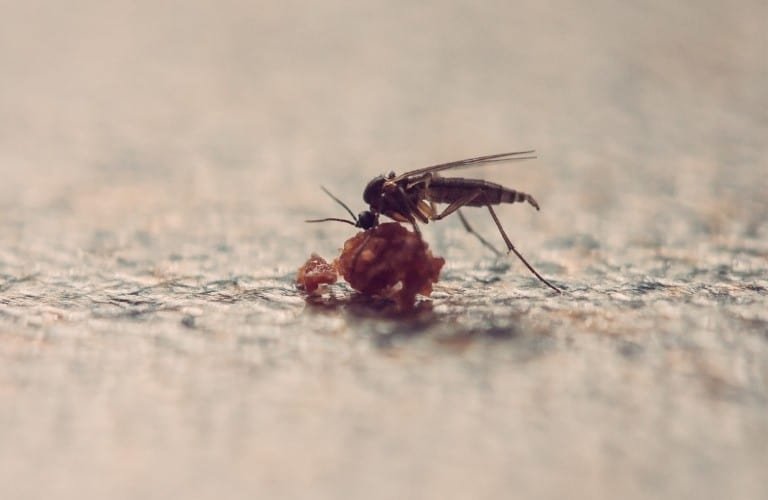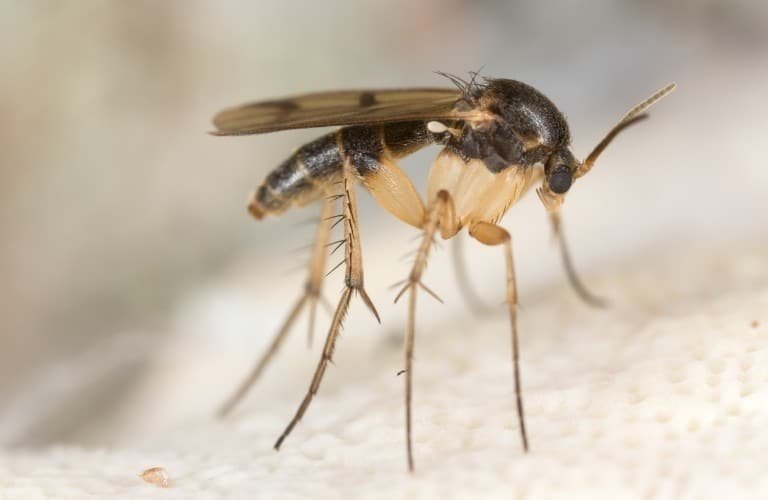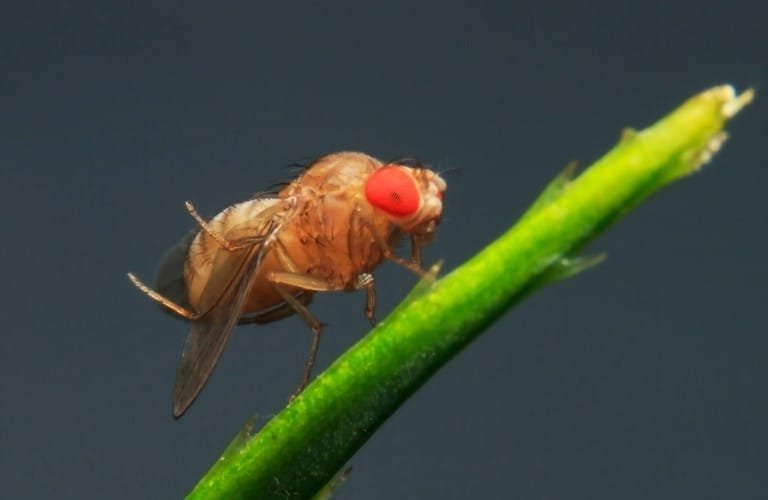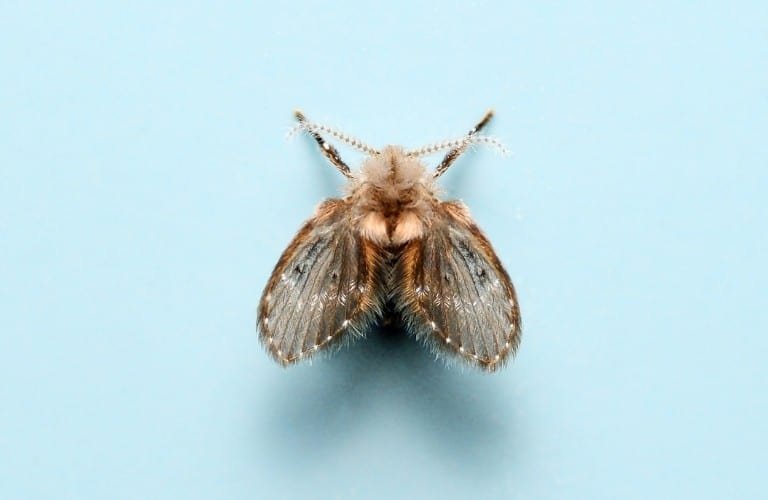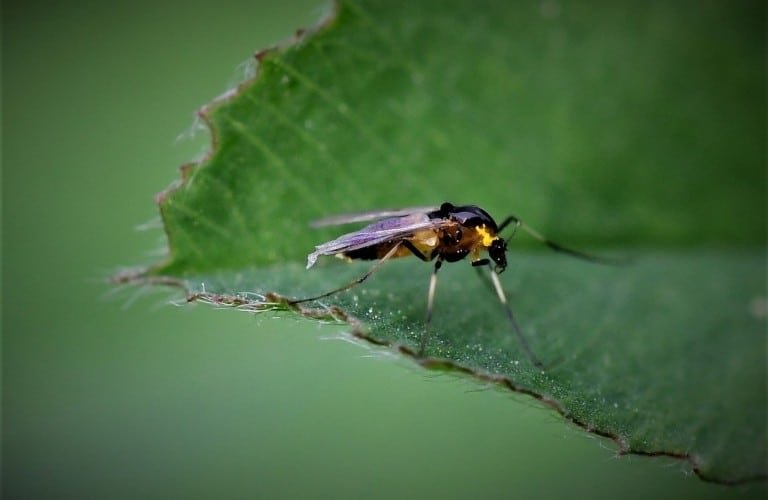There are many varieties of those tiny, flying insects commonly known as gnats. The most common varieties you find in your house are fungus gnats, fruit flies, and drain flies.
Although common gnats found in your home are annoying, these types do not bite, spread disease, or cause significant damage inside your house.
Gnats breed frequently so it can appear that an infestation happens almost overnight and without warning.
How do gnats get in my house? Gnats come inside your home seeking moisture, warmth, and food. They enter through open doors or windows, via undetected eggs on produce, or by plants brought indoors. Dry, clean conditions, traps, or insecticides can rid your home of gnats and larvae.
In the following, you’ll learn how to identify gnats, how they get inside, and what you can do to get them out of your home.
Need a complete guide for preventing and eliminating gnat infestations? You’ll find everything you need here.
Identifying the Gnat
Even though killing gnats (find the best traps and sprays here) is much the same regardless of the type, knowing their hang-out spots makes it easier to eliminate their source of attraction.
Fungus Gnats
These gnats, also known as winter gnats, live and reproduce in overly moist potting soil in houseplants. They are only about ¼ inch long with black bodies, wings, and long legs.
A female gnat will lay hundreds of eggs in the soil of just one houseplant, easily causing an infestation and severe plant damage (learn more here).
Fruit Flies
Fruit flies are attracted to food spills and rotting food and produce, in addition to sweet items such as honey and wine.
They are primarily found buzzing around kitchen counters and sinks. They are about the same size as fungus gnats but are tan or light brown with red eyes.
Head over to this article to learn more about the different types of fruit flies and what you can do to prevent them from becoming a problem.
Drain Flies
Drain flies, or moth flies, breed in gunk-filled drains, in dirty garbage disposals, and under sinks with leaky faucets.
Their prime source of attraction is moisture and decomposing organic matter.
They are also tiny with dark, scaly wings and move in quick, jerky hops instead of smooth flight. When crushed, they turn to dust.
What Are Gnats Attracted to?
All common varieties of house gnats are attracted to moisture in some way, shape, or form, whether it be overly moist houseplant soil, leaky faucets, or wet, grimy drainpipes.
Even the very air we exhale attracts gnats due to the carbon dioxide and – you guessed it – the moisture it contains.
This is one reason you often find yourself swatting gnats away from your face, but they are also attracted to our sweat and other bodily fluids (find out which ones here).
You can find gnats in any and every room in the house if they find ideal conditions for living and breeding.
For a complete list of common gnat attractants, be sure to read this.
In the Kitchen
The kitchen is one of the most common destinations for gnats, especially fruit flies.
Because there are so many places in the kitchen where moisture, spoiling food, organic slime in drainpipes, dirty garbage disposals, and garbage can be found, gnats feel right at home.
Once gnats find moist, humid locations, they begin the breeding. Females lay eggs by the hundreds, so indoor populations can quickly soar.
Wondering if you’re in danger of suffering from numerous gnat bites as they glide through the air in your kitchen? Find the answer here.
Sinks
Gnats can be found in kitchen sinks because they are a source of constant moisture.
Dirty dishes in the sink give them the opportunity to feed off spoiling, unscraped food particles.
There is a lot of prime, decomposing, organic material left under sink stoppers and inside garbage disposals.
Drains
Unless cleaned regularly, there is a lot of “organic slime,” the black sludgy substance that forms over time, in kitchen sink drains and pipes.
It consists of oil, grease, and decomposing foods, which is a hot spot for gnats to live and breed.
Garbage
Leaky garbage bags can allow liquids and other old food to spill out into garbage cans and create a source of attraction and food for gnats.
Fruit flies are attracted to rotting fruits and vegetables left spoiling in uncovered garbage cans.
Leaks
A dripping kitchen faucet, leaky pipes, or sweaty pipes found under the kitchen sink are another favorite spot for gnats. It’s that dark, moist environment perfect for laying eggs.
How to Prevent Gnats in the Kitchen
The best way to prevent gnats in the kitchen is to keep things really clean. Here are a few tips:
- Use bleach or a commercial drain cleaner (this one is all natural) to keep drains and pipes clean.
- Immediately wipe up food spills, grease, and water from countertops.
- Do not store dirty dishes in the sink.
- Keep garbage cans covered, and clean with a disinfectant or bleach once a week.
- Fix leaky pipes and dripping faucets.
- Store produce in the refrigerator or inside covered airtight plastic storage containers.
In the Bathroom
Providing an alternate source of moisture and gunk-filled drains, bathrooms are another popular spot to find gnats in the home.
Sinks
Gnats, especially drain flies, live and breed in dirty sink drains.
Over time, bathroom sinks get clogged up with hair, oil, and black gunk that accumulates with time, making them quite attractive to gnats.
Additionally, toothbrushes are typically stored directly beside the sink, and if you’re brushing your teeth as recommended, your toothbrush is almost always nice and damp.
Showers
Showers provide the moisture and dirty drain conditions similar to sinks. Standing water in slow-moving shower drains is another source of attraction.
Drains
Clogged and slow-moving drains, in addition to dirty drain pipes found under the bathroom sink, provide ideal breeding conditions for gnats.
Poor Ventilation
Steamy, humid conditions provide the moisture-rich, humid conditions that attract fungus gnats and drain flies.
How to Prevent Gnats in the Bathroom
Keeping your bathroom as clean and dry as possible is the best prevention. Dry countertops and floors right away if puddles form and don’t leave wet towels in a heap on the floor.
Additionally:
- Run a fan after showering or bathing to remove as much moisture and humidity as possible.
- Fix leaky or dripping faucets and pipes.
- Keep drains clear and clean frequently with bleach or a commercial drain cleaner.
In the Bedroom
There’s nothing more annoying than gnats flying around your face and head as you try to fall asleep.
Gnats are attracted to perspiration (sweat), and they also like sweet-smelling hair products. lotions, and perfumes. But there’s more…
Food
If you have teenagers, you may find gnats in the bedroom if unclean plates are stacked up in the bedroom or garbage cans containing food scraps or soft drinks are left in an uncovered garbage can.
Water Issues
Gnats in the bedroom can also indicate a moisture problem like a leaky roof.
Gutters filled with rotting yard debris attract gnats which may then get in through a gap in the window or broken screen.
How to Prevent Gnats in the Bedroom
Again, use cleanliness and dry conditions to make gnats feel unwelcome.
- Check for water leaks and broken seals around windows, and keep gutters on the roof line clean.
- Avoid wearing perfumed lotions and body sprays before turning in for bed.
- Empty garbage cans and do not leave dirty dishes or half-full soda or juice containers lying around the room.
In the Living Room
You can find fungus gnats on the living room walls and flying around houseplants as they are attracted to moist soil and humid conditions.
Plants
Fungus gnats are drawn to overly watered soil in houseplants.
Gnat larvae feed on the fungus found in the soil, in addition to munching on houseplants roots. If disturbed, gnats will swarm up from plants as you water them.
Plants may suffer root rot, stunted growth, or wilted, yellow leaves. Plants may even die an untimely death if gnats aren’t controlled promptly.
Lights
Bright lights attract fungus gnats. They will swarm around plants under a heat lamp and regular table lamps if they are bright.
How to Prevent Gnats in the Living Room
Start by switching your light bulbs to low-wattage bulbs, like these dimmable 40-watt bulbs, to discourage gnats. Also:
- Keep houseplant soil as dry as possible.
- Place sticky gnat traps (these are super effective) in houseplants to catch and kill fungus gnats.
- DIY sprays made from one-part peroxide or vinegar diluted with three parts water sprayed on plants kills gnats and larvae.
In the Basement
Gnats love the moist, humid conditions found in basements. If there are sweating pipes, leaking pipes, standing water in bathroom sinks, and dirty drains, gnats will infest the basement.
Laundry Tubs
Laundry tubs are another source of moisture and dirty drains – ideal conditions for breeding gnats.
Floor Drains
Floor drains are not only a source of standing water, but the water can be filled with fungus and gunk. Gnats live in, breed, and fly up from basement floor drains.
How to Prevent Gnats in the Basement
Running a dehumidifier is one of the best methods for keeping gnats out of your basement, as it will help keep the basement cool and dry.
This dehumidifier on Amazon worked well for my basement.
No products found.
No products found.
It is capable of removing 5 gallons of moisture from the air per day and allows you to set your desired humidity level.
It will then cycle quietly as it senses the need for moisture removal.
All you need to do is to empty the collection bucket when full, either manually or with the included hose.
Other tips include:
- A couple of drops of dishwashing soap poured into a floor drain once a month helps keep pipes clear and clean.
- Pour a half cup of bleach and run hot water down shower and sink drains to kill gnats and larvae.
- Wring out wet mops and clean pails after cleaning, and allow them to dry thoroughly before storing in the basement.
Final Thoughts
The bad news is that gnats can get into your house easily by flying in, from an unsuspecting plant brought in from outdoors, or unseen eggs already ready to hatch on fresh produce.
The good news is that once you spot fungus gnats, fruit flies, or drain flies, you now know how to take immediate action to get rid of them.
Keeping things clean and dry are the two biggest things you can do to keep gnats from infesting your home.
From there, set gnat traps to catch them at the source, whether under kitchen cabinets or in houseplants.
If all else fails, a good, natural insecticide spray should do the trick.
Knowing what attracts gnats and eliminating those sources, followed up by preventative maintenance measures, will guarantee you a gnat-free home.
Want more helpful tips for beating gnat problems?
Check out our gnat section for prevention guides, recommended products to use, best elimination techniques, and more!

